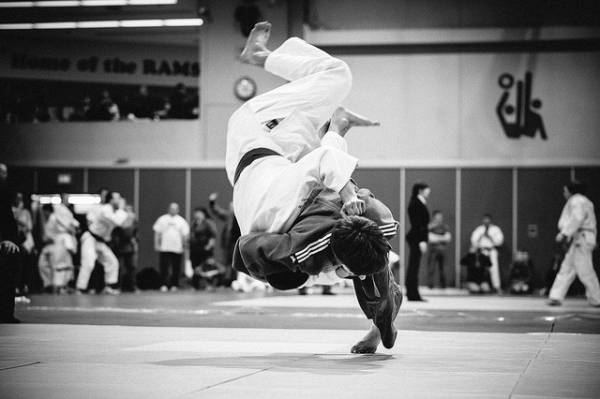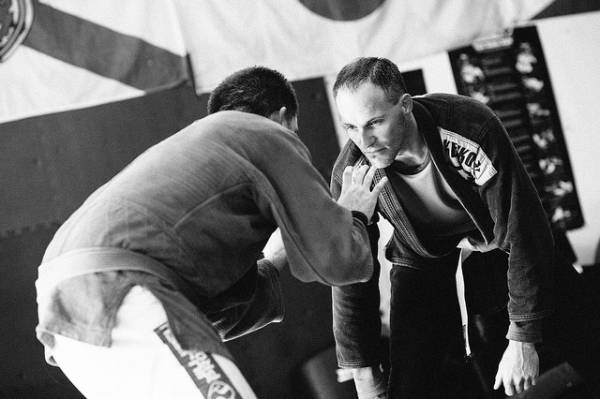Photos provided by David Brown Photography.
In the last few weeks I’ve had requests for articles on training older guys and the benefits of crawling and strength training for martial artists. All this got me thinking that given how deluded people are, there are plenty of older guys just starting to get into martial arts who could use some helpful training tips.
Photos provided by David Brown Photography.
In the last few weeks I’ve had requests for articles on training older guys and the benefits of crawling and strength training for martial artists. All this got me thinking that given how deluded people are, there are plenty of older guys just starting to get into martial arts who could use some helpful training tips.
I hate to bash old guys when it comes to training, because I feel like I do it all the time (and I’m one of them), but one of the things about getting older is supposed to be greater self-awareness and perception, and that doesn’t seem to be the case mostly.
3 Rules for Older Guys Doing Martial Arts
Rule #1 – Recovery
You need more rest to recover from training than your younger classmates. In your head you may think you’re the second coming of Randy Couture, but you’re not. Unless you’ve spent your entire life as a professional athlete before taking up martial arts you are going to suffer. In the book The Path to Black Belt, Rodrigo Gracie and Kid Peligro recommend only training twice per week to begin with so that the body can adapt and get used to the beating that is involved in constant practice. Consider the source and how many beginner martial artists the Gracies have trained and then follow suit.
Don’t be fooled into thinking you don’t need more recovery. Ice is your friend, contrast showers may be your best friend, and you most certainly need weekly massage. Massage is absolutely vital for older athletes who are still trying to push hard.
Rule #2 – Responsibility
Along with more recovery you’re going to need to spend more time looking after yourself. If you’re about my age then you’ve got responsibilities. Speaking for myself, as a business owner one of the main reasons I stopped BJJ was because I was getting to the point where I wasn’t able to demonstrate good movement at work the next day. If you get your arm broken you may find that your ability to earn money for your family and pay your mortgage is decreased.
To make sure that you’re robust enough to deal with the hardships of martial training, you will need to spend about the same amount of time working on your physical self as you do on your combat skills. Some of this time will need to be spent on strength work and some (at least an equal amount) on flexibility. Don’t be the old guy in a martial arts class who can’t kick above waist high. As a friend of mine who was on the national team for Taekwondo says, “It looks like two trees fighting.”
Rule #3 – Relax
 Not all of your training needs to be hard. I know it seems counterintuitive, especially when you start to think that you’ve already given up years of time to all those younger guys around you, but if you start going all out all the time you’re going to quickly wind up hurt. Martial arts is a lifelong journey, not a sprint for the next two months. Display the kind of maturity you’re supposed to have and accept that you are in this for the long haul. Giving up a session this week to make sure you can train for the next four is well worth it. That extra session you’re thinking about right now could wind up being twelve you end up missing. It’s hardly worth the cost.
Not all of your training needs to be hard. I know it seems counterintuitive, especially when you start to think that you’ve already given up years of time to all those younger guys around you, but if you start going all out all the time you’re going to quickly wind up hurt. Martial arts is a lifelong journey, not a sprint for the next two months. Display the kind of maturity you’re supposed to have and accept that you are in this for the long haul. Giving up a session this week to make sure you can train for the next four is well worth it. That extra session you’re thinking about right now could wind up being twelve you end up missing. It’s hardly worth the cost.
Putting It Together
I know you’re mother thinks you’re a Navy SEAL, wrapped-in-armor, astronaut ninja, but frankly you’re not that special. (Again, for readers who have previously missed my test for “special” athletic abilities – check for an Olympic medal around your neck. No medal = not special. Deal with it). What you need is a simple plan that allows you to get the most bang for your buck in terms of training, recovery, and injury proofing.
The 70-Minute Old Guy Workout Routine
0-10 minutes: Primal Move. I suggest doing one of the four Primal Move workouts I’ve previously done for Pulse Beat Fit. Why? Because it works, and gets the body and brain warmed up.
11-20 minutes: Stretch. If you’ve moved around a bit you’ll have found some places where you’re stiff. Stretch them. Do not avoid this under any circumstances. That stiffness is your body giving you a sign that right now the brakes are on. You can run a car hard while the brakes are on but sooner or later something will catch fire. Pay attention to your body and grease the hot spots prior to running your engine hard.
21-50 minutes: Strength. You get three exercises and ten minutes each. Don’t be dopey and turn this into thirty minutes of complexes or other metcon work. Your mat time will more than take care of whatever fitness you need. Think of this time as bulletproofing the body. I don’t believe in push/pull when working on a minimal schedule. I like to go two push and then a lower pull or vice versa (e.g. bench press and dips then deadlift, or barbell cleans and pull ups followed by squats). A simple three sets of five, going up in weight each set, will suffice. I know you can do more, but you’re in this for the long haul, not just today. And, if you exhaust yourself in the gym you leave yourself open to a nonresponsive body when someone goes to rip your arm off in training.
51-60 minutes: Stretch again. Yes, it’s that important. You’ll find that other things are likely now stiff and sore, and you need to get that oilcan out again and lube them up so your car is ready to go again.
61-70 minutes: Primal Move. Repeat the same flow you did to start with. Pay attention to how your body feels. If it feels worse you did it wrong. Training should make you feel better, not worse.
 You should do this seventy-minute routine three times per week. On week one do an upper push/lower pull workout followed by upper pull/lower push, before finishing the week with the push workout again. In the following week reverse the order and hit pulls twice with the push workout splitting them up.
You should do this seventy-minute routine three times per week. On week one do an upper push/lower pull workout followed by upper pull/lower push, before finishing the week with the push workout again. In the following week reverse the order and hit pulls twice with the push workout splitting them up.
If you follow that session outline three days per week and train martial arts the other three, that’s six days of work. On the seventh day you need massage and an hour of just stretching. Alternate these workouts with your martial training and you’ll find that over time you’re able to continue training injury free.
Don’t get caught up like many do at the start of their journey and train every day – most of those guys don’t last. If you’re serious about martial arts an extra session this week won’t mean much compared to the next ten years that you’ll be able to train for if you look after your body.






